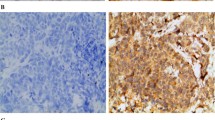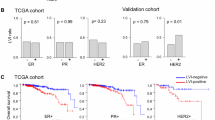Abstract
Purpose
Cx26, which is a constituent of the connexin family, has recently been shown to promote metastasis through enhancing the vascular invasion in mouse melanoma cells. In this study, we have investigated whether or not Cx26 expression is associated with vascular invasion and recurrences in human breast cancers.
Experimental design
Cx26 expression was studied in 152 invasive breast cancers by immunohistochemistry. In order to investigate the blood vessel invasion and lymphatic vessel invasion with precision, immunohistochemical staining of blood vessels and lymphatic vessels was carried out using anti-CD34 and anti-D2-40 antibodies, respectively.
Results
Cx26 was positive in 51.3% (78/152) of the breast tumors. A statistically significant association was observed between Cx26 expression and large tumor size (P = 0.013) or high histological grade (P = 0.043). Frequency of blood vessel invasion was higher in Cx26-positive tumors (5.1%, 4/78) than in Cx26-negative tumors (1.4%, 1/74) though not statistically significant (P = 0.210). Lymphatic vessel invasion was significantly (P = 0.001) more frequent in Cx26-positive tumors (39.7%) than in Cx26-negative tumors (14.9%). Patients with Cx26-positive tumors showed a significantly (P < 0.001) poorer prognosis than those with Cx26-negative tumors. Multivariate analysis showed that Cx26 (P < 0.05) expression was an independent prognostic factor.
Conclusions
Cx26 expression is associated with lymphatic vessel invasion, large tumor size, high histological grade, and poor prognosis in human breast cancers. Cx26 seems to enhance the metastasis probably through promoting the lymphatic vessel invasion. Cx26 might be clinically useful as a new prognostic factor.



Similar content being viewed by others
References
Charles AC, Naus CC, Zhu D et al (1992) Intercellular calcium signaling via gap junctions in glioma cells. J Cell Biol 118:195–201
Monaghan P, Moss D (1996) Connexin expression and gap junctions in the mammary gland. Cell Biol 20:121–125
Willecke K, Eiberger J, Degen J et al (2002) Structural and functional diversity of connexin genes in the mouse and human genome. Biol Chem 383:725–737
Bruzzone R, White TW, Paul DL (1996) Connections with connexins: the molecular basis of direct intercellular signaling. Eur J Biochem/FEBS 238:1–27
Ma XD, Ma X, Sui YF, Wang WL (2002) Expression of gap junction genes connexin32 and connexin43 mRNAs and proteins, and their role in hepatocarcinogenesis. World J Gastroenterol 8:64–68
Haass NK, Smalley KS, Herlyn M (2004) The role of altered cell–cell communication in melanoma progression. J Mol Histol 35:309–318
Mourelle M, Casellas F, Guarner F et al (1995) Induction of nitric oxide synthase in colonic smooth muscle from patients with toxic megacolon. Gastroenterology 109:1497–1502
Jinn Y, Ichioka M, Marumo F (1998) Expression of connexin32 and connexin43 gap junction proteins and E-cadherin in human lung cancer. Cancer Lett 127:161–169
Huang RP, Hossain MZ, Sehgal A et al (1999) Reduced connexin43 expression in high-grade human brain glioma cells. J Surg Oncol 70:21–24
Tsai H, Werber J, Davia MO et al (1996) Reduced connexin 43 expression in high grade, human prostatic adenocarcinoma cells. Biochem Biophys Res Commun 227:64–69
Laird DW, Fistouris P, Batist G et al (1999) Deficiency of connexin43 gap junctions is an independent marker for breast tumors. Cancer Res 59:4104–4110
Eghbali B, Kessler JA, Reid LM et al (1991) Involvement of gap junctions in tumorigenesis: transfection of tumor cells with connexin 32 cDNA retards growth in vivo. Proc Natl Acad Sci USA 88:10701–10705
Huang RP, Fan Y, Hossain MZ et al (1998) Reversion of the neoplastic phenotype of human glioblastoma cells by connexin 43 (cx43). Cancer Res 58:5089–5096
Lee SW, Tomasetto C, Paul D et al (1992) Transcriptional downregulation of gap-junction proteins blocks junctional communication in human mammary tumor cell lines. J Cell Biol 118:1213–1221
Hellmann P, Grummer R, Schirrmacher K et al (1999) Transfection with different connexin genes alters growth and differentiation of human choriocarcinoma cells.Exp Cell Res 246:480–490
Lee HJ, Lee IK, Seul KH et al (2002) Growth inhibition by connexin26 expression in cultured rodent tumor cells. Mol cells 14:136–142
Momiyama M, Omori Y, Ishizaki Y et al (2003) Connexin26-mediated gap junctional communication reverses the malignant phenotype of MCF-7 breast cancer cells. Cancer Sci 94:501–507
Ito A, Katoh F, Kataoka TR et al (2000) A role for heterologous gap junctions between melanoma and endothelial cells in metastasis. J Clin Invest 105:1189–1197
Ito A, Koma Y, Uchino K et al (2006) Increased expression of connexin 26 in the invasive component of lung squamous cell carcinoma: significant correlation with poor prognosis. Cancer Lett 234:239–248
Jamieson S, Going JJ, D’Arcy R et al (1998) Expression of gap junction proteins connexin 26 and connexin 43 in normal human breast and in breast tumours. J Pathol 184:37–43
Goldhirsch A, Wood WC, Gelber RD et al (2003) Meeting highlights: updated international expert consensus on the primary therapy of early breast cancer. J Clin Oncol 21:3357–3365
Goldhirsch A, Glick JH, Gelber RD et al (2005) Meeting highlights: international expert consensus on the primary therapy of early breast cancer 2005. Ann Oncol 16:1569–1583
Xie H, Laird DW, Chang TH et al (1997) A mitosis-specific phosphorylation of the gap junction protein connexin43 in human vascular cells: biochemical characterization and localization. J Cell Biol 137:203–210
Krenacs T, Rosendaal M (1995) Immunohistological detection of gap junctions in human lymphoid tissue: connexin43 in follicular dendritic and lymphoendothelial cells. J Histochem Cytochem 43:1125–1137
Koval M (2006) Pathways and control of connexin oligomerization. Trends Cell Biol 16:159–166
Kato T, Kameoka S, Kimura T et al (2002) Blood vessel invasion as a predictor of long-term survival for Japanese patients with breast cancer. Breast Cancer Res Treat 73:1–12
Van der Auwera I, Van den Eynden GG, Colpaert CG et al (2005) Tumor lymphangiogenesis in inflammatory breast carcinoma: a histomorphometric study. Clin Cancer Res 11:7637–7642
Acknowledgement
The authors are deeply grateful to Professor Hiroshi Nojima (Department of Molecular Genetics, Research Institute for Microbial Diseases, Osaka University) for his valuable and helpful advice on the planning of this study.
Grant support: Grant-in-Aid for Cancer Research from the Ministry of Health, Labor and Welfare of Japan for Scientific Research on Priority Areas from the Ministry of Education, Culture, Sports, Science and Technology of Japan.
Author information
Authors and Affiliations
Corresponding author
Rights and permissions
About this article
Cite this article
Naoi, Y., Miyoshi, Y., Taguchi, T. et al. Connexin26 expression is associated with lymphatic vessel invasion and poor prognosis in human breast cancer. Breast Cancer Res Treat 106, 11–17 (2007). https://doi.org/10.1007/s10549-006-9465-8
Received:
Accepted:
Published:
Issue Date:
DOI: https://doi.org/10.1007/s10549-006-9465-8




